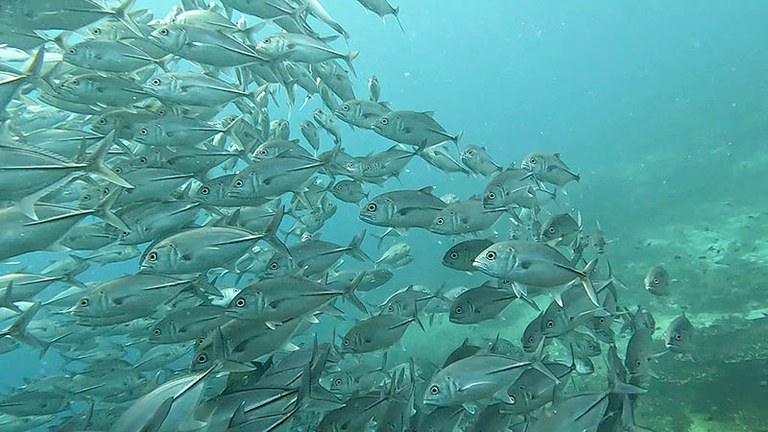Bigeye trevally fish in Indonesia
Schools of bigeye trevally are some of the abundant reef fish thriving in the Indonesian Raja Ampat Marine Conservation Area, considered to be the global epicenter of marine biodiversity. Conservation of local coral reefs, reef fish and marine megafauna (including manta rays, several species of whales and whale sharks) support dive tourism, creating jobs for residents, generating tourism revenues for local communities, and safeguarding local food security. USAID first started supporting biodiversity conservation in the Bird's Head Seascape, which includes the Raja Ampat Marine Conservation Area, under the USAID Global Conservation Program (1999 to 2009) and more recently under a partnership with the Walton Family Foundation. The Raja Ampat area is one of the most biodiverse regions in the world and includes, at last count: 603 species of hard coral species, representing 75% of all known coral species; 699 species of mollusks; 38 species of endemic reef fish; and the world record for 374 different reef fish recorded on a single dive. Location: Raja Ampat Marine Conservation Area, Kri Island, Southwest Papua, near Sorong, Indonesia Photographer: Barbara Best
https://biodiversitylinks.org/projects/current-global-projects/ace/ace-images/bigeye-trevally-fish-in-indonesia.jpg/view
https://biodiversitylinks.org/projects/current-global-projects/ace/ace-images/bigeye-trevally-fish-in-indonesia.jpg/@@download/image/Bigeye-trevally-fish-in-Indonesia.jpg
Bigeye trevally fish in Indonesia
Schools of bigeye trevally are some of the abundant reef fish thriving in the Indonesian Raja Ampat Marine Conservation Area, considered to be the global epicenter of marine biodiversity. Conservation of local coral reefs, reef fish and marine megafauna (including manta rays, several species of whales and whale sharks) support dive tourism, creating jobs for residents, generating tourism revenues for local communities, and safeguarding local food security. USAID first started supporting biodiversity conservation in the Bird's Head Seascape, which includes the Raja Ampat Marine Conservation Area, under the USAID Global Conservation Program (1999 to 2009) and more recently under a partnership with the Walton Family Foundation. The Raja Ampat area is one of the most biodiverse regions in the world and includes, at last count: 603 species of hard coral species, representing 75% of all known coral species; 699 species of mollusks; 38 species of endemic reef fish; and the world record for 374 different reef fish recorded on a single dive. Location: Raja Ampat Marine Conservation Area, Kri Island, Southwest Papua, near Sorong, Indonesia Photographer: Barbara Best



